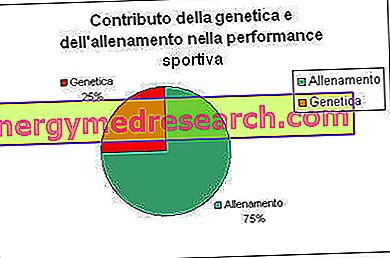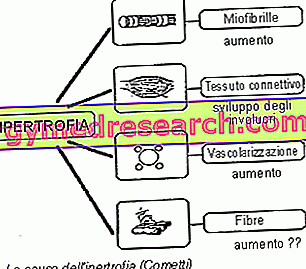There is a relationship between exercise intensity and fat consumption, we find out which one The energy needed to satisfy the body's energy demands derives in a different percentage from the oxidation of CARBOHYDRATES (plasma glucose and muscle glycogen), PROTEINS AND LIPIDS (fatty acids from adipose tissue and muscle triglycerides)
Category physiology of training
The importance of genetics in sports performance. As usual ... genetics! Athletic performance unfortunately depends not only on the level of training, but also on the genetic predisposition that allows us to achieve it. If genetics is against us, we could do a lot of training but we certainly could not become champions (for the same reason that a mule will never become a horse)
Muscle contraction, as well as many other cellular functions, takes place thanks to the energy released by the breakdown of the phosphoanhydride bond that combines the phosphorus α to the phosphorus ß in the ATP molecule: ATP + H2O = ADP + H + + P + Energy available The muscle cell has limited ATP reserves (2.5
Below is a table for calculating the power index. By monitoring its variations during the year it is possible to obtain an estimate of improvements or worsening in terms of muscular hypertrophy. Click on the image to view the fax machine Or: Download the file in pdf
Before talking about training methods to increase muscle development, let's try to define two different concepts, hypertrophy and hyperplasia. Muscle hypertrophy: increase in muscle volume due to the increase in volume of its component elements (fibers, myofibrils, connective tissue, sarcomeres, contractile proteins, etc
See also: supercompensation and training Supercompensation or a dissociated diet is a food strategy that aims to increase muscle glycogen reserves. Having more glycogen available is useful in all those enduring sports where there is a strong depletion of muscle reserves such as cycling and marathon. With the same oxygen consumed, glucose (deriving from glycogen) is in fact able to produce a greater amount of energy than fatty acids
Muscle strength is the motor capacity that allows us to overcome a resistance or to oppose it through the development of tension on the part of the musculature. By trophism, however, referring to the very young, we mean the possession of a well-structured and balanced tonic musculature between the various segments of the body
There is a relationship between exercise intensity and fat consumption, we find out which one The energy needed to satisfy the body's energy demands derives in a different percentage from the oxidation of CARBOHYDRATES (plasma glucose and muscle glycogen), PROTEINS AND LIPIDS (fatty acids from adipose tissue and muscle triglycerides)
Message sent by: Paolo Hi Paul, your maximum heart rate is normal considering the age. If during a maximal effort you reach 160 beats per minute it is natural that you are unable to run for a long time at a heart rate above 150 bpm. In fact, your anaerobic threshold is in all probability placed at a heart rate between 144 and 150 bpm
definitions Power : amount of energy (ATP) produced in the unit of time. ENGINE HORSES. Capacity : total amount of ATP that could be synthesized if all the energy substrates available for that metabolic pathway were consumed. HOW MANY GASOLINE IS IN THE TANK. Energy yield : ATP moles synthesized per mole of initial substrate consumed
The anaerobic threshold is an estimate of the ability to sustain a prolonged exercise. Its value indicates the maximum intensity of exercise corresponding to a constant level in the blood lactate concentration (about 4mmol / liter). The anaerobic threshold is also the point of massive activation of the anaerobic mechanism, that is, that point of demarcation between moderate and intense exercise










